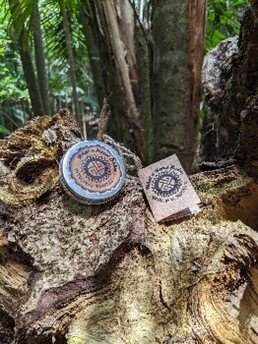What a Nerve Balm
What A Nerve Balm Is formulated to help ease nerve pain, such as sciatica, neuropathy and trigeminal neuralgia.
To also sooth and heal shingles, herpes, cold sores.
 This balm has been formulated by a qualified, experienced Herbalist, harnessing all the powers of Mother Nature, combined with empirical and scientific research, to help ease shooting nerve pain, such as sciatica, trigeminal neuralgia, and neuropathy. To help to sooth and heal shingles, herpes and cold sores. The specific herbal concentrates have been extensively researched for their abilities to inhibit viral replication on topical application.
This balm has been formulated by a qualified, experienced Herbalist, harnessing all the powers of Mother Nature, combined with empirical and scientific research, to help ease shooting nerve pain, such as sciatica, trigeminal neuralgia, and neuropathy. To help to sooth and heal shingles, herpes and cold sores. The specific herbal concentrates have been extensively researched for their abilities to inhibit viral replication on topical application.
This ointment is extremely moisturising, can be used as a lip balm. It does not stain, and has a beautiful scent of rose geranium and lemon balm.
Directions:
Gently massage into infected or painful areas, as needed.
Ingredients:
30gms
Organic infused essential oils and herbal concentrates:
Hypericum perforatum
St John’s wort
St John’s wort has a traditional reputation throughout Europe to heal wounds and was used as a folk medicine in medieval times for all anxiety nerve related problems.
Extensive European research has hailed this herb as an anti-depressant as well as inhibiting nerve related viruses.
The herb can be used for nervous exhaustion, long term anxiety, it is also thought to reduce nerve pain and neuralgia.
Actions:
Antidepressant, nervine tonic, antiviral, especially to enveloped viruses such as herpes simplex strains, wound healing, antimicrobial (topically)
Mellissa officinalis
Lemon balm
Melissa means Bee in Greek, as the Bees love this herb.
Traditionally this herb has a history as a tonic remedy, which raises the spirit and comforts the heart. The volatile oils calm the nervous system, reduce spasms, nervousness, panic, and anxiety.
New research has shown that this herb is particularly antiviral to the herpes simplex virus. The clinical studies showed that the average healing time of cold sores was halved to about 5 days and the time between outbreaks was lengthened dramatically.
The polyphenol constituents and volatile oils combine together to help combat nerve viruses and also produce a calming effect.
Actions:
Relaxant, antiviral (both topically and internally), anti-spasm, nerve tonic, calming to digestive system.
Pelagonium roseum
Rose Geranium
Geranium species are indigenous to Southern Africa and prefer warm temperate tropical climates. Recent research has found Rose Geranium oil effective for nerve pain (neuropathy) and for depression. Applied directly to the skin for nerve pain especially the pain following shingles. Rose Geranium has a beautiful earthy rose scent.
Actions: Antiviral, antibacterial to staphylococcus aureus, anti-inflammatory, anti-oxidant.
These plants are toxic to cats, dogs and horses. ASPCA
Organic Beeswax (Australia)
Beeswax is a naturally occurring wax produced by female worker bees. Eight glands in the abdominal segment secrete this wax to build the honeycomb.
Beeswax is exceptional as it forms an antibacterial barrier, keeping the moisture in the skin, whilst also allowing the skin to breath. Beeswax is extremely high in Vitamin A, enhancing skin elasticity and stimulating cell rejuvenation.
Organic Beeswax means the bees are not exposed to flowers that have been sprayed with agricultural chemicals, the hives are chemical free and the pests that affect the bees are treated naturally.
Production of Beeswax:
Lanolin
Lanolin is secreted by the sheep’s sebaceous glands. This wool wax helps prevent evaporation of water from the skin. It also has antibacterial qualities which help to protect the sheep from fungal/bacterial infections. Lanolin is a similar chemical composition to our skin; it forms an emulsion with water that’s easily absorbed by the skin and this stops the dehydration of the skin. So safe, it’s been used as the most effective nipple whilst breastfeeding new born babies.
Herbal concentrate:
Glycyrrhiza glabra
Licorice root
The glycyrrhizic acid found in the root is 50 times sweeter than cane sugar, and is a very extensively cultivated anti-inflammatory found in both European and Asian dispensaries.
The glycyrrhizin works in a similar way to cortisone and stimulates the production of adrenal hormones whilst reducing the breakdown of steroids by the liver and kidneys. The soothing demulcent qualities of liquorice provide a thick protective coating throughout the digestive system, especially useful for ulcerations.
The glycyrrhizin (GL) has been shown to inhibit virus growth, especially towards the herpes simplex virus.
Actions:
Anti-inflammatory, providing a soothing demulcent coating, stimulates the adrenals, laxative.
Homoeopathic: Hypericum 30c
In homoeopathy the whole flowering plant is chopped and steeped in alcohol to make the tincture. Homoeopathy works on energetic principles and a 30C or higher preparation is typically used for acute traumas. Hypericum has an affinity with the nervous system and has been extensively researched and found successful for shooting pains along the nerves, and to repair damage to nerve rich areas. It may also be used for puncture wounds. This remedy is ideal for use before and after spinal injuries and surgery.
References:
A Clinical Guide to Blending Liquid Herbs: Herbal Formulations for the Individual Patient” 2003 Kerry Bone Elservier Science (USA)
A Modern Herbal; 1994 Mrs M. Grieve F.R.H.S. First published in 1931 by Johnathan Cape Ltd. Great Britain. A Cresset Press Book
E/S/C/O/P Monographs Second Edition supplement 2009
The Encyclopedia of Medicinal Plants, 2001 Andrew Chevallier, Dorling Kindersley Pty Ltd
Warning: These herbal infusions are a superfood in the rawest form. They are not to replace prescription medication from a medical professional. Please seek medical advice for any ongoing health conditions. If allergies occur, discontinue use.
Price: $25 plus $10 postage